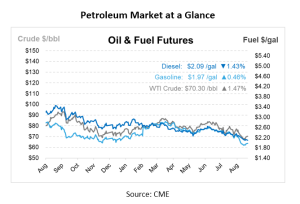
Oil Prices Stuck Between Hurricane Fallout and Fed Rate Cut Predictions
Attention is shifting from hurricane remnants to tomorrow’s Federal Reserve meeting. Traders remain uncertain about the Federal Reserve’s anticipated rate cut and its potential impact on oil markets but are predicting a 50-basis point rate cut. A lower interest rate could boost economic growth and increase oil demand. Concerns over weaker demand in China have kept prices down. However, prices are facing upward pressure from expectations of reduced US stockpiles and lingering production issues following last week’s storm.
Hurricane Francine has left the Gulf Coast with over 12% of U.S. Gulf of Mexico crude oil production remaining offline, as the U.S. Bureau of Safety and Environmental Enforcement (BSEE) reported. A total of 213,204 bpd of oil is still not operational. The hurricane has led to the shutdown of 2.37 million barrels of oil. As of Monday, 24 oil and gas platforms remain evacuated, down from a peak of 171 platforms last week.
China’s refinery output dropped for the fifth consecutive month in August, declining 6.2% year-over-year to 13.91 Mbpd, driven by weak fuel demand and poor export margins. Year-to-date, refinery throughput is down 1.2% compared to the same period in 2022. Despite peak gasoline season, overall consumption has been lower than expected, with diesel demand weakened by the economic slowdown and increased use of liquefied natural gas as a truck fuel.
Planned maintenance at major refineries and soft export margins further limited production in China, although independent refiners saw a slight rebound in output. Meanwhile, China’s crude oil production rose by 2.1% in August, continuing a trend of healthy growth in the sector.
The UK’s offshore oil and gas industry has reportedly achieved its target of cutting emissions by 25% four years ahead of the 2027 deadline, according to Offshore Energies UK (OEUK). This early success was reached by power efficiency improvements and flaring and venting reductions. The industry reduced its emissions by 28% compared to 2018 levels, and methane emissions were cut by more than half, meeting targets seven years early.
Despite the UK’s goal of achieving net zero emissions by 2050, OEUK emphasized that oil and gas will remain essential for decades, focusing on reducing domestic production’s carbon footprint. Looking ahead, emissions from the sector are expected to decline further due to reduced output and more efficient operations.
However, OEUK warned that the country’s oil and gas production could halve in the next six years unless favorable fiscal and regulatory policies are implemented. The North Sea still holds the potential for hefty oil and gas resources, equivalent to 13.5 billion barrels.

This article is part of Daily Market News & Insights
Tagged:
MARKET CONDITION REPORT - DISCLAIMER
The information contained herein is derived from sources believed to be reliable; however, this information is not guaranteed as to its accuracy or completeness. Furthermore, no responsibility is assumed for use of this material and no express or implied warranties or guarantees are made. This material and any view or comment expressed herein are provided for informational purposes only and should not be construed in any way as an inducement or recommendation to buy or sell products, commodity futures or options contracts.





